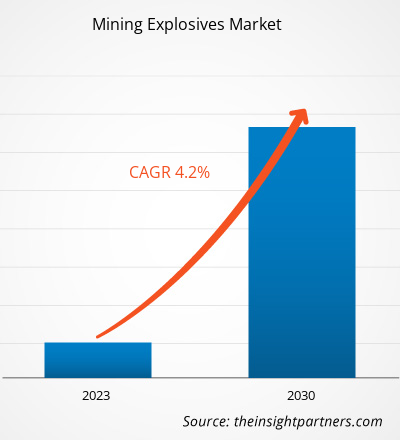[研究报告] 2022 年矿用炸药市场规模为 183.5355 亿美元,预计到 2030 年将达到 250.9262 亿美元;预计 2023 年至 2030 年的复合年增长率为 4.2%。
市场分析
矿用炸药是高速反应的化合物。矿用炸药根据其密度、爆速、爆炸热、质量强度、临界直径和耐水性等特性进行分类。炸药的生产采用精密的技术、优质的原材料,并高度重视采矿作业的安全。硝酸铵燃料油 (ANFO) 是地下采矿和地面硬岩采石作业中最广泛使用的炸药之一。这类炸药在煤炭工业的采矿和采掘中得到广泛应用。
增长动力与挑战
制造高端产品需要稳定的金属和矿物等原材料供应。对金属的需求不断增长,需要增加采矿活动以提取和生产所需的原材料,最终导致大量使用矿用炸药来开采矿床、清除覆盖层和破碎岩石。此外,随着金属需求的增长,矿业公司越来越注重改善安全措施和运营效率。这包括改进矿用炸药技术和配方,以优化爆破作业。具有更好破碎能力、更低振动和更高安全性能的矿用炸药有助于提高生产率并最大限度地减少环境影响。汽车、航空航天、医疗设备、电子、国防和军事、能源生产、建筑施工、奢侈品以及许多高端产品制造行业都使用金属。在汽车行业,豪华车、跑车、电子产品和其他高端车辆都使用轻质而坚固的金属(例如铝、钛和高强度钢)制造。航空航天和汽车等高端产品制造业的增长推动了对金属的需求,进而提振了全球矿用炸药市场。此外,采矿作业必须遵守严格的环境和安全标准,以尽量减少对生态系统、水资源和社区的影响。遵守这些标准需要实施缓解措施、监测计划和报告要求。全球各地的矿业公司都必须确保其运营符合这些标准,这可能涉及高昂的成本和运营调整。因此,这一因素可能会抑制全球矿用炸药市场的增长。
您可以免费定制任何报告,包括本报告的部分内容、国家级分析、Excel 数据包,以及为初创企业和大学提供优惠和折扣
矿用炸药市场:战略洞察

-
获取此报告的顶级关键市场趋势。此免费样品将包括数据分析,从市场趋势到估计和预测。
报告细分和范围
《2030年全球矿用炸药市场预测》是一项专业且深入的研究,主要关注全球矿用炸药市场的趋势和机遇。该报告旨在提供市场概览,并根据类型、应用和地域对市场进行详细细分。全球矿用炸药市场近年来经历了高速增长,预计未来仍将保持这一趋势。报告提供了全球矿用炸药使用情况及其主要地区和国家需求的关键统计数据。此外,报告还对影响主要地区和国家矿用炸药市场表现的各种因素进行了定性评估。报告还对主要市场参与者及其关键战略发展进行了全面分析。此外,报告还包含多项市场动态分析,以帮助识别关键驱动因素、市场趋势和利润丰厚的矿用炸药市场机会,从而有助于确定主要收入来源。
此外,生态系统分析和波特五力分析提供了全球采矿炸药市场的360度视角,有助于了解整个供应链和影响市场增长的各种因素。
节段分析
全球矿用炸药市场根据类型和应用进行细分。根据类型,市场细分为三硝基甲苯 (TNT)、铵油炸药 (ANFO)、黑索今 (RDX)、季戊四醇四硝酸酯 (PETN) 等。根据应用,市场细分为采石场和非金属矿开采、金属矿开采和煤矿开采。
按类型划分,铵油炸药 (ANFO) 领域在 2022 年全球矿用炸药市场占有相当大的份额。ANFO 的重量百分比约为 94% 的铵和 6% 的燃料油。按应用划分,煤炭开采领域在全球矿用炸药市场中占据主导地位,市场份额最大。煤炭是世界上最丰富的电力来源,其发电量占全球发电量的 36% 以上。与其他矿产相比,煤炭储量巨大。煤炭开采是许多发展中经济体重要的发电来源。
区域分析
该报告详细概述了全球矿用炸药市场,涵盖五大主要区域:北美、欧洲、亚太地区(APAC)、中东和非洲 (MEA) 以及南美和中美。亚太地区占据了全球矿用炸药市场的很大份额,2022 年市场价值约为 135 亿美元。亚太地区涵盖多个发展中和发达经济体,包括中国、印度、日本、印度尼西亚和澳大利亚。中国、印度、印度尼西亚和澳大利亚是主要的煤炭生产国,位列全球五大煤炭生产国之列。此外,由于金属开采和采石活动的增加,亚太地区的矿用炸药市场需求持续稳定。
预计北美将迎来显著增长,到2030年预计将达到约25亿美元。北美拥有强大的采矿业和多个协会,包括美国勘探与采矿协会和国际爆破工程师协会。在欧洲,采矿活动中广泛使用炸药。预计这将为采矿炸药市场创造丰厚的利润。欧洲采矿炸药市场预计在2022年至2030年期间的复合年增长率约为3%。
行业发展和未来机遇
合作、收购和新产品发布是全球采矿炸药市场参与者采用的主要策略。
2023年3月,澳瑞凯有限公司推出了4D散装炸药系统,这是一款适用于地下、露天煤矿和露天金属矿开采的先进散装系统。该产品提供广泛的能量范围,以适应不同的岩石特性和矿山设计要求。
2023年3月,Omnia Holding Ltd旗下散装矿用炸药业务与PT Multi Nitrotama Kimia签署了有条件的股份买卖协议,并成立了一家合资企业。合资企业名为PT Kemitraan MNK BME,提供适用于露天矿和地下矿的一体化炸药产品。
新冠疫情的影响/地缘政治局势的影响/经济衰退的影响
新冠疫情导致的封锁、旅行限制和企业倒闭对全球各国的经济和各行各业造成了不利影响。这场危机扰乱了全球供应链、制造活动、交付计划以及必需品和非必需品的销售。这些中断限制了矿用炸药的供应,造成生产延误和成本增加,对矿用炸药的整体供应产生了负面影响。在新冠疫情期间,许多采矿作业暂停或缩减,以遵守封锁措施并确保工人安全。采矿活动的减少导致对矿用炸药的需求下降。此外,疫情还影响了全球经济,导致大宗商品价格波动,矿产和金属需求下降。因此,矿业公司对投资持谨慎态度,这影响了他们对矿用炸药的需求。
随着各国政府宣布放宽限制措施,全球市场正在从损失中复苏。随着各国逐步从疫情中恢复,疫苗接种工作持续推进,采矿活动正在反弹。制造商被允许满负荷生产,以弥补供应缺口。许多地区增加的基础设施投资和刺激计划推动了对矿产和金属的需求。因此,预计全球矿用炸药市场将在2022年至2030年期间强劲增长。
采矿炸药市场区域洞察
Insight Partners 的分析师已详尽阐述了预测期内影响矿用炸药市场的区域趋势和因素。本节还讨论了北美、欧洲、亚太地区、中东和非洲以及南美和中美洲的矿用炸药市场细分和地理分布。
采矿炸药市场报告范围
| 报告属性 | 细节 |
|---|---|
| 2022年的市场规模 | 183.5亿美元 |
| 2030年的市场规模 | 250.9亿美元 |
| 全球复合年增长率(2022-2030年) | 4.2% |
| 史料 | 2020-2021 |
| 预测期 | 2023-2030 |
| 涵盖的领域 |
按类型
|
| 覆盖地区和国家 |
北美
|
| 市场领导者和主要公司简介 |
|
矿用炸药市场参与者密度:了解其对业务动态的影响
矿用炸药市场正在快速增长,这得益于终端用户需求的不断增长,而这些需求的驱动因素包括消费者偏好的不断变化、技术进步以及对产品优势的认知度不断提高。随着需求的增长,企业正在扩展产品线,不断创新以满足消费者需求,并抓住新兴趋势,从而进一步推动市场增长。

- 获取矿用炸药市场主要参与者概览
竞争格局和主要公司
Orica Limited、Al Fajar Al Alamia Co SAOG、Dyno Nobel、中国保利集团公司、日本油脂株式会社、韩华集团、安徽江南化工有限公司、高丽诺贝尔炸药、Solar Group 和 Omnia Group Company 是全球采矿炸药市场的主要参与者。
- 历史分析(2 年)、基准年、预测(7 年)及复合年增长率
- PEST和SWOT分析
- 市场规模、价值/数量 - 全球、区域、国家
- 行业和竞争格局
- Excel 数据集
近期报告
相关报告
客户评价
购买理由
- 明智的决策
- 了解市场动态
- 竞争分析
- 客户洞察
- 市场预测
- 风险规避
- 战略规划
- 投资论证
- 识别新兴市场
- 优化营销策略
- 提升运营效率
- 顺应监管趋势






















 获取免费样品 - 矿用炸药市场
获取免费样品 - 矿用炸药市场